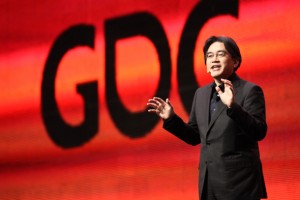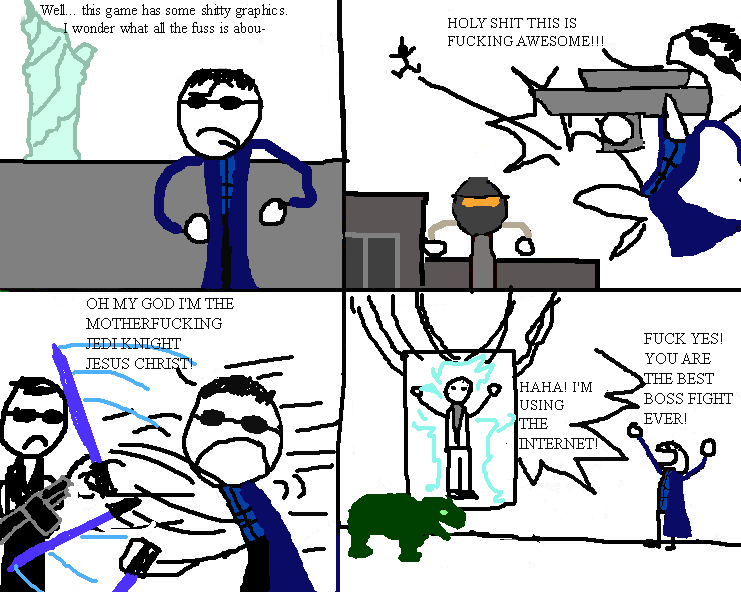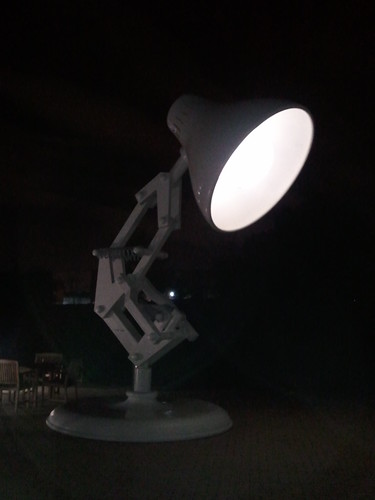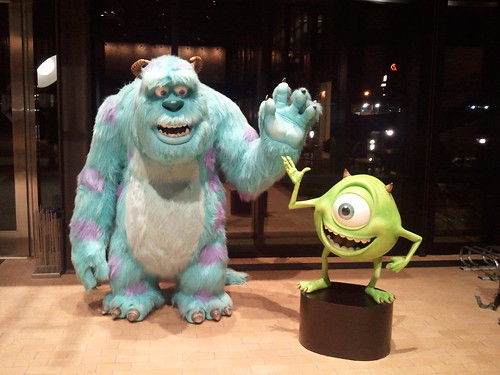GDC2011: A Fabulous Drift, Part 2
March 10, 2011 12:10 am Game Development, Games for Fun, Gaming, LifeGDC2011: A Fabulous Drift, Part 1, found here.
—
The previous day put the hurt on me. The thick drapes were drawn tightly and not a single photon passed through my 25th floor window. All the better, because any amount of noise of light would have made me throw up anyway.
8:45 am. Time to roll out of bed and see what Nintendo has to offer.
Clothes on and I’m out the door, my roommate whom is equally hungover is stumbling along with me. I vaguely recall telling him the keynotes are generally skipable, but he really wants to go as it’s his first GDC, and I decide to prove to myself, and him, that I am capable of doing this.
We get to North hall where the keynote is being held. The room is already pretty full, but we manage to find some decent seats a bit off the center stage. We end up sitting near a few other 343 folks by happenstance.
On the previous day, we decided to start spreading the rumor that Nintendo would be giving out free 3DSes too all keynote attendees. In the past, Nintendo has had a history of giveaways at their keynotes. Last year was some dance / rhythm game that was very difficult and I only touched once.
Our plan had worked. We over heard numerous people talking about the possibility of getting a free 3D handheld gaming system. Mission successful.
A little after 9am, Mr. Iwata came on stage. Most of his speech felt like one giant plug for Nintendo. Lots of talk about the 3Ds which everyone is going to buy anyway.
Reggie comes on. Iwata is a nice guy, but boring to listen to. I think they bring Reggie out to pick the energy up a bit. I end up nodding off anyway. Many 3Ds features were announced including Netflix on the 3Ds. Okay, but what does that have to do with games? Isn’t this a game developers conference? Some new Zelda games gets shown that looks a lot like previous Zelda games. No one is excited.
Something starts to irk me. Iwata brings up Call of Duty as a well connected online game, but uses Playstation as the platform example! Then he mentions afterward that Microsoft should be recognized for it’s dedication to online networking? Whaaa? Okay, so I’m probably nitpicking here, but why does Sony get credit as the primary platform for Call of Duty? Sigh.
Anyway, afterward I look at my buddy and tell him “See, we could have slept in.” He agrees and tells me “Man, you have done this before.”
We head to our first session of the day. We get a chuckle out of a few people complaining about not getting free 3Dses on the way out.
—
The first session is called Levelshop: From Grid Paper to Playable, Whiteboxes on Demand from 2d Drawings presented by Harvey Fong (Bioware). This turns out to be one of my favorite talks from GDC mainly because he shows up an awesome tool I always wish I had.
The tool to create levels, Inkscape (free) is pretty straight forward. If you’ve used a drawing program like Visio you’ll be right at home. Designers create levels in a drawing program using 2D shapes. They then use a markup language on the shapes to define how they will be turned into 3D objects. So, if a rectangle is labeled “2,” then it’ll be two meters high. “@2” will start the rectangle 2 meters above zero, and so on.
Other cool features include the ability to define the border of the shapes which basically makes rails along the top of the rectangle. Ramps and ceiling pieces are done though Visio like connectors. So, drawing a line between two boxes and connecting them will automagically create ramps which is nice for connecting up spaces.
Fong showed his example level exported into three different EA engines running with AI. Pretty awesome stuff, as the 2D drawing basically spits out an XML file that gets sent to a server then generated into a 3D mesh based on the engine it’s being made for.
He then did a live demo, making a simple level in 2D in a few minutes, then had it up and running in game after another minute or so. At EA, they use this tool for early level design development. Pretty powerful stuff and great for iteration times on level ideas.
I’m feeling the effects of the previous night worse then ever. Daddy needs a sandwich and a nap. I get my grub on and pass out back at the Marriott.
—
The next talk I attend is called Break It Down! How Harmonix and Kinect Taught the World to Dance; The Design Process and Philosophy of Dance Central presented by Matt Boch (Harmonix Music) and Dean Tate (Harmonix Music Systems). Whoooo boy, that’s a mouthful.
The talk didn’t offer up many surprises. Someone at Harmonix basically said, “Make a dance game!” So a strike team of people began prototypes. They went through six prototypes, each one building on the next. They started very simple, with hitting buttons for moves as they went by on the screen. Later, they put a character on the screen and made it dance as the player would complete moves. Fairly straight forward stuff.
The kicker is they didn’t know what tech they would use. At the time, Kinect was just a gleam in a Microsoft employee’s eye, so Harmonix was thinking more along the lines of a DDR pad or a WiiMote. However, once they saw the Kinect, they knew it would be a perfect match and the rest is history.
Really, the only misstep they took was when they did a strange prototype of people waving their hands in the air at colored blocks. Imagine if the blocks from Rock Band were flying at your face and you were doing dance moves in time to hit them. The problem is that people would just wave their hands and hit blocks, and not actually do dance moves.
Eventually, they went back to prototypes that looked a lot more like the shipped game after deciding to not go after an audience of people who wouldn’t dance and weren’t into dancing anyway.
The other cool thing I learned about Harmonix was how awesome their studio culture in. They believe if you’re going to make a game about dancing, you should learn how to dance. They actually had something called “Dance Possies” that would break out and practice dancing and play the game at work. They paid for dance lessons for their employees and would go to classes regularly down the street.
How awesome is that? I think the management really gets it there, and if you’re a Harmonix employee you’re a lucky person. It’s also easy to see why all of their games are of such high quality based on how their employees are treated.
—
The final talk of the day was titled Player-Driven Stories: How Do We Get There? by Kent Hudson (LucasArts).
Kent claims there’s a problem with games, in that the medium doesn’t take advantage of interactivity. Linear story telling can be told better in other mediums, so why do linear story telling? The other problem is that players aren’t driving the story, even if the character is.
His goal? Have the player make influential decisions that create unique narrative that is not prescribed by a designer. Sounds pretty good, but I wish I would have asked him why he thinks Call of Duty is the #1 selling IP in the Universe right now, and it flies in the face of everything he’s saying.
Really, his goal turns out to be creating a unified agency, or making the player agency the same as the character’s agency. It’s weird when the character wants one thing and player wants another. It’s also bad for the game.
Kent points out that players are willing to trade off fidelity for agency to make the world feel more reactive. Passage (it wouldn’t be GDC without a Passage reference) only has the verb of movement. But passage is an emotionally charged, low-fidelity game. Because it is low-fi, players project more of themselves into it. He claims designers should move players with agency opposed to a scripted series of events. Again, all I can think about is Call of Duty.
Kent gives some methods to make the game more low-fi in order to get more out of the game and make the game more reactive.
- VO can be made part of the world instead of coming from a character. Imagine the Joker talking to Batman in Arkham asylum through loudspeakers and TVs and such.
- Writing should be made to react to generic events. If a character is mad, happy, pleased, confused, and so on, the game can recognize this. The game must simply feel like it noticed what they did and the writing can be systematized.
- Text is fine! Use it. Simlish is fine too. Katamari is a good example of this.
- Environments? Reuse!
- Animation? Use restraint, which will free up more animations for gameplay.
Kent points out that a rift between the fidelity of story and the game mechanics is bad. The world should not feel “separate” from the mechanics and they should all feel like one unified experience. He uses hacking in Deus Ex as an example where this is done well. If you want to hack, you can, because you character is a hacker guy. If you decide to use this, dialogue trees change, you might find different paths a goodies and the story might even change. Can’t disagree here, Deus Ex is one of my favorite games of all time. He also quotes of of the developers of the game saying that the reason it could be made, was because it was so low-fidelity. Making a game of that depth would be hard these days it seems. Sad.
He talks about relationship tracking systems and how they are pretty straight forward. You basically track “amplitude” versus “alignment”. So killing your best-friend has high amplitude and a negative alignment, where as feeding a homeless person is low amplitude and positive alignment. I think this works for lots of games, but what if the homeless person is a rapist? What if you best friend is fucking your wife? I guess these things are unknown by the player / character so maybe they don’t count. Or maybe they get factored into each axis differently.
Kent brings up manageable fidelity, and uses Bioshock 2 as an example. He claims that creating tension over time in a three act structure is still a good thing, and that creating moments isn’t bad either. Sweet! He wants to do it in a more procedural way, where relationship tracking is used to see what the player is doing, then around particular, semi-random intervals around a three act structure, certain events are presented. So, pick the big relationships and do something interesting with them on schedules.
So in Bioshock 2, schedules for Big Sister encounters were used instead of in set place arenas. They were purely systemic so the event could happen at any time. As player defined his connection with story and characters, the Big Sister events would play out anywhere in the world. An AI nightmare to be sure. I feel bad because I beat the game and missed the fact that this was happening at all. I get into arguments all the time about creating systems like this because people often miss the fact that this is happening to them, but maybe that’s the point? Then again, if data shows that people rarely replay the campaign of a game, why put all the effort into these systems that people don’t notice at all? Cut some corners and put them in set places, then you can really make them pop.
Again, this is what Call of Duty does. Cha-ching.
Anyway, he sums it up by saying designers should let the player decide when events should happen, that we’re not letting the player create meaningful stories and that stories based on player’s stories and actions is where we get meaningful player driven stories.
I agree with many of his points, but then again, it seems the masses are demanding more and more directed and scripted experiences. Those games will never stop being made considering how many copies are sold and how many people play them. Certain people want to get all interactive and make their own story, and other people want to sit back basically watch an interactive movie with some light involvement along the way. The great thing there’s room for all of these concepts and they’re all video games.
—
Near the end of the talk, I get a few text messages. A co-worker wants to make dinner plans. I agree to go with, until I find out we’ll be driving somewhere. To Oakland in fact.
This changes things.
I’ve not heard many good things about Oakland, but I’m always down for new places and adventures, so I throw my hat over the wall. A few of my other co-workers decide not to go, as they feel driving over the Bay Bridge will take too long and they don’t want to leave the convention center area, a decision they will forever regret.
I meet up with my posse, we pile in the car, and head across town. The drive over the Bay Bridge is far from scenic. It doesn’t even touch the drive across like Washington over the 520 or the I-90.
Along the way, I find out we’re meeting a friend of DJ, the driver, someone who works at Pixar, named Hudson. Yes, the Pixar. She informs me they used to work together, and she was an intern at Pixar at one point. She tells me Hudson is in a band as well, and has practice with them later. So we’ll eat dinner at an amazing Korean Noodle house (YuYu Za Zang) and head back to some parties.
Just outside the restaurant we meet Hudson. We head into the restaurant and it’s very hole in the wall. Florescent lighting. The 10 or so combos are printed, back-lit behind them above the counter. I begin to question the legitimacy of the deliciousness factor.
Korean soaps are playing on a TV high above where we sit, and some of the staff is standing around watching them. I have no idea what to order, so I rely on the people who took me here to tell me what to get.
“Za Zang Noodes!” my DJ exclaims. Something about black bean paste and onions and homemade noodles and okay yeah this sounds good lets do it. We also order some crispy beef (battered and fried beef strips which are crispy and comes with a sweet sauce), some pork stew and some dumplings.
It all tastes amazing. DJ was right, I should have never doubted her. I’m a Korean noodle convert.
I start chatting up Hudson about his band. He plays base, and tells me that at Pixar, they do a battle of the bands event every year. Even though there’s only like 600 people that work there, there are numerous bands and they have enough to do a massive event. Pretty crazy. Hudson, like most people in a creative industry is a super nice, awesome, and down to Earth guy.
Hudson gets a text. He seems a little sad then says “Well, my band just went out to eat. They’re going to get hammered afterward too I bet.”
Then a pause. And a coy smile.
“Well, I have some time to kill. Want to come check out the studio?”
We’re all a bit stunned. He just asked us if we would like to take a personal tour, by him, around the inside of Pixar.
Let me think about that one… yes please!
All I can think about now is the poor suckers who decided not to come out because they thought the drive (which took 10-15 minutes) would be too far out of Union Square. One more reason to go with the flow and seize the moment.
—
We pull up to the gate at Pixar. They have the classic movie studio entrance with a guardhouse and two gate arms on either side. We get our badges from security and we drive through.
Just outside of the main entrance is a giant ball and Lumo lamp towering above us. Once we go in, the first thing I notice is a case to the right of all the Oscars and other awards the studio has won. I point them and Hudson tells me that’s only a portion of them. Crazy.
The interior is amazing. Art from the films is everywhere. I’m overwhelmed and want to spend hours here just looking at everything.We decide to take some pics with Mike and Scully from Monsters Inc. and a huge Lego Woody and Buzz. People are playing some pool to our left, behind the security desk.
Eventually we head upstairs where original hand animations from Chuck Jones are on display. I’m blown away by the skill and detail on each pieces. Original renders of Wile Coyote show him as a much beefier character at one point with a larger chest and arms. We also head to the other side where we see many of the concepts from Toy Story, including Woody and Buzz concepts. Again, crazy to see how much that character changed. Buzz used to be more red, white and blue and Woody’s face was just all over the place.
Hudson points out the face on board of 20 faces which looks the most like the current Woody. “It’s funny how one will just stand out and that’s the one everyone will revolve around.” It’s true, I’ve seen this before with game concepts as well.
We get to see some of the theaters as well. It’s probably the nicest movie theaters I’ll ever go into in my life. One is huge, like a class theater, just nicer. Hudson tells us they have a direct fiber connection to Skywalker Ranch and can pipe movies into this theater directly. The other theater is smaller, and filled with couches. I wish I could watch a movie there sometime.
Downstairs, we get near the voice over recording area, where we pass a wall that everyone who records VO signs. We spend some time pointing out our favorite actors, including Tom Hanks (near the top left of the wall), Don Rickles and even yes, Larry the Cable Guy. Banksy would have a field day in here.
Next, Hudson takes us into the actual offices. I see some stuff I probably can’t talk about so I won’t. But, the thing that stands out is how much effort they put into decorating the office spaces. Some people work in standalone sheds, dressed up like houses complete with their own porches, doors and windows. The entire space feels like being at Disneyland. Not one square inch is left un-themed. We enter into a jungle themed area, and one office is tiki themed to the max. Even the windows have low, fake lights outside to make it feel like the “house” is sitting along the edge of a bayou at night.
And fully stocked bars in each wing! An adult playground, no doubt. Hudson tells us about some of the secret hidden rooms, including the Love Lounge that requires you to get on your hands and knees, crawl through a tunnel, then into a secret room with a bar. Apparently all the stars go there and sign the wall inside as well. He tells us about another room that requires people to pull on a statue and a wall of books turns, just like the movies, and exposes the hidden room. If I ever go back I’m going to find these places.
Finally, we get to see Renderfarm, which has a sassy “Open 24/7” sign hanging humorously above the servers. As we walk by, we notice fake arms and legs sticking out from underneath the servers, another reminder of how awesome Pixar really is.
Eventually, its time to leave. We all take some more pictures including the four of us sitting in a comically oversized chair and pretending to be action figures trapped in a huge Toy Story action figure box.
We thank Hudson a million times and we begrudgingly leave. At this point, partying seems like a bad idea. Do I really want to ruin this experience by doing some heavy drinking tonight and killing all those braincells?
No. I think I’ll keep these memories as intact as possible. I turn in early, savoring the experience as best I can. It’s really the best way the night could possibly end.
Plus, tomorrow is a big party night, including a “mixer” put on at The W by our studio and the Microsoft party afterward. I must steel myself for future shenanigans.
—






March 11th, 2011 at 10:52 pm
Have you been able to track down the levelshop software? I took down the web address from his slides, but I either copied it wrong or it’s simply inaccessible. And the slides aren’t up in the vault, yet.
Also, the player-driven stories talk was awesome. Got me really excited.
March 12th, 2011 at 6:35 pm
I found Inkscape, so creating drawings and marking them up is possible, but ran into the same problem- The URL he gave didn’t work. Then I realized that the URL was maybe just a pointer to the server he was using to crunch all the data and make those 3D models? Then whatever comes out would go your game engine of choice. I’m waiting for the vault to open too so I can figure that out.